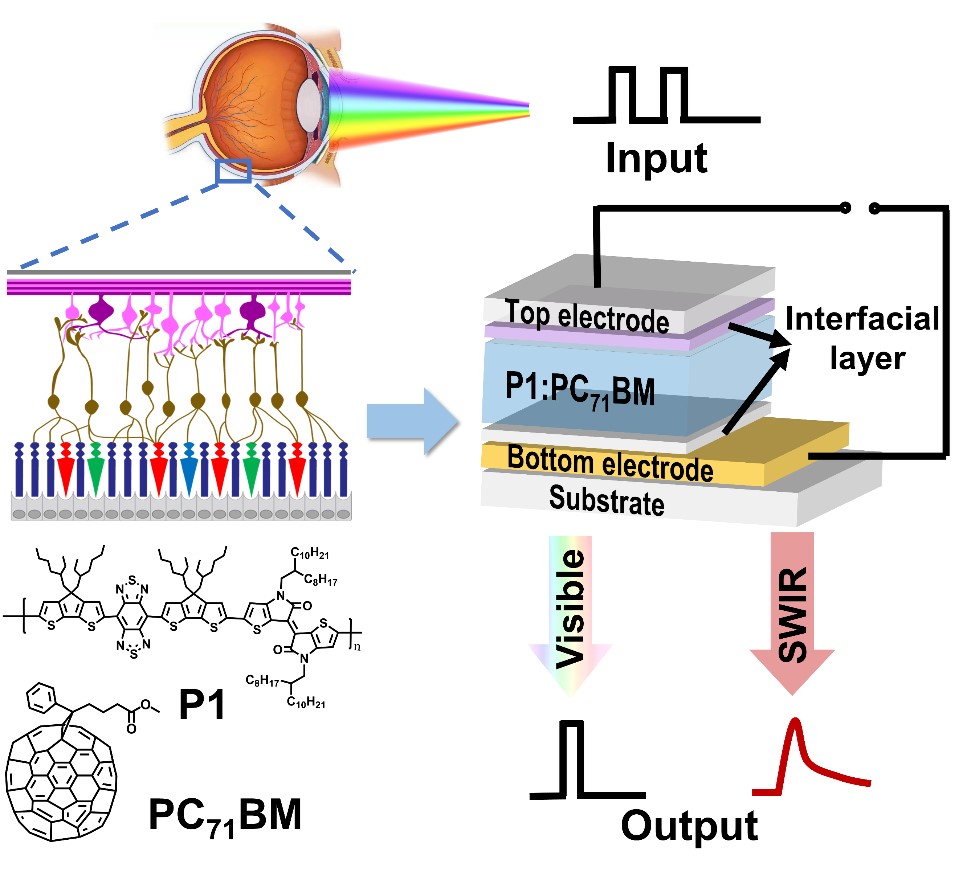An enormous amount of neurons and synapses in the human body (especially in the brain) help humans perceive the surrounding environment, receive various external information, and achieve learning and memory functions. One of the key functions of the human visual system, which can acquire 80% of external information, is the ability to distinguish between various colors (wavelengths of light). Photonic synapses with the dual function of optical signal detection and information processing are often used in artificial vision systems to mimic the functions of the human visual system. However, most of the currently reported photonic synaptic devices have a light response range consistent with the absorption range of the photoreceptor material and cannot exhibit synaptic behavior only for a specific wavelength range. Therefore, it remains a challenge to mimic the function of the human visual system to discriminate different wavelengths of light signals.
Recently, we published a research entitled "Retina-Inspired Organic Photonic Synapses for Selective Detection of SWIR Light" (DOI:10.1002/anie.202213733) in the journal Angew. Chem. Int. Ed. In this work, a narrow-band conjugated polymer P1 (band gap 0.69 eV) was designed and synthesized to achieve the first organic photonic synapses with selective detection to short-wave infrared light. The working mechanism is rooted in the energy level barriers of donor and acceptor materials and the unbalanced charge transport mobilities.

In the article, the devices with photodiode structure were prepared using the polymer material P1 as a single component, and organic photonic synaptic devices (SM-PS) responding to the full spectral range of visible to short-wave infrared light were obtained. Later, a type I heterojunction based on P1 and PC71BM was constructed to obtain selectively respond photonic synapses (Sel-PS) that exhibit synaptic behavior only under SWIR light irradiation.
The article tests the synaptic performance of the devices using 1550 nm laser as the stimulation signal. The paired-pulsed facilitation (PPF) is an index to evaluate the short-time plasticity of synapses, which is related to the short-term plasticity (STP) for temporary information recognition and decoding in the biological neural system, and the PPF value of Sel-PS devices can reach 1.3. Long-time plasticity (LTP) of synapses is the basis for human learning and decision-making, when the synaptic device will reach a new conductive state, and the state retention time of Sel-PS devices is more than 1500 s, which is consistent with the memory process of the human brain. The energy consumption of Sel-PS devices is as low as 2.85 fJ per pulse, which is comparable to the energy consumed by a single neural activity in the human body (1-10 fJ). In addition, synaptic weights can be modulated by varying light intensity, duration time, frequency, and the number of pulses in the same way that the human visual system perceives changes in light signal stimulation.
The article confirms the charge trapping and de-trapping processes of SM-PS and Sel-PS devices by means of transient absorption spectroscopy (TA), fluorescence spectroscopy (PL), and morphological analysis under illumination conditions. And it extends to other material systems, confirming the universality of the SWIR light-selective response photo-synaptic strategy constructed in the work.Finally, the Sel-PS device arrays were successfully applied to letter imaging with noise reduction function, and the array devices still output similar imaging results to those without interference signals. This work provides a new strategy for achieving selectively responsive organic photonic synapses.
The first authors of the article are doctoral students Wang Song and Chen Hao of the group, and the corresponding author is Professor Huang Hui.


